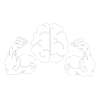Iron is one of the most critical nutrients for your body, playing an essential role in oxygen transport, energy production, and overall well-being. Despite its importance, iron deficiency is the most common nutritional deficiency worldwide, especially among women and children. In this blog, we’ll explore its causes, symptoms, and practical solutions to tackle iron deficiency effectively.
Why Is Iron So Important? #
Iron is a key component of hemoglobin, the protein in red blood cells responsible for carrying oxygen from your lungs to every cell in your body. It also supports:
- Energy production
- Immune function
- Hormone synthesis
When iron levels drop, your body struggles to perform these essential functions, leading to noticeable symptoms.
Symptoms of Iron Deficiency #
Iron deficiency often develops gradually, and the symptoms can be subtle at first. Watch out for these common signs:
❌ Fatigue and low energy
❌ Shortness of breath, even with light activity
❌ Frequent headaches
❌ Brittle nails
❌ Pale skin
❌ Hair fall or thinning
❌ Cold hands and feet
❌ Dizziness or lightheadedness
These symptoms worsen as the deficiency progresses, so it’s crucial to address iron deficiency early.
Who Is Most at Risk? #
Iron deficiency is particularly common in:
- Women (especially during childbearing years due to menstrual blood loss)
- Children (due to growth demands and imbalanced diets)
- Vegetarians and vegans (due to poor absorption of plant-based iron)
In fact, iron deficiency has reached endemic levels in certain populations.
Causes of Iron Deficiency #
Several factors contribute to iron deficiency:
1. Not Eating Enough Iron-Rich Foods #
Iron comes in two forms:
- Heme Iron: Found in animal-based foods, especially red meat, and is easily absorbed.
- Non-Heme Iron: Found in plant-based foods but is poorly absorbed by the body.
✅ Best sources of Iron:
- Red meat, poultry, seafood (high in heme iron)
- Lentils, beans, spinach, fortified cereals (sources of non-heme iron)
⚠️ Vegetarian diets can lack sufficient iron, making supplementation or careful meal planning necessary. Pairing non-heme iron foods with Vitamin C-rich foods (like citrus fruits, tomatoes, and bell peppers) enhances absorption.
⚠️ Fortified foods may contain iron, but they often come with health concerns, such as added sugars and synthetic ingredients.
2. Poor Iron Absorption #
Even if your diet includes iron-rich foods, poor absorption can still cause deficiency. Factors that impact absorption include:
- Low stomach acid: Essential for breaking down and absorbing iron.
- Excess antacid or PPI (proton pump inhibitor) use: These medications reduce stomach acid, hindering iron absorption.
- Excess grain consumption: Grains contain phytates, which bind to iron and block absorption.
- Excess coffee or tea (especially during meals): These contain polyphenols that interfere with iron uptake.
- Heavy metals in the body: High levels of heavy metals can interfere with iron utilization.
3. Excess Calcium #
Calcium competes with iron for absorption in the gut. If your diet is calcium-heavy (e.g., excess milk, cheese, or supplements) without enough iron, it can significantly lower iron levels.
⚠️ This is particularly common among children, where diets often emphasize calcium through milk products while ignoring iron-rich foods.
4. Blood Loss #
For women, blood loss during:
- Periods
- Fibroids
can deplete iron stores over time.
✅ Solution: Women in their fertile years need to prioritize iron-rich foods to replenish lost stores.
How to Test for Iron Deficiency #
If you suspect iron deficiency, the following blood tests can confirm it:
- CBC (Complete Blood Count): Checks for low hemoglobin and red blood cell levels.
- Iron Panel: Provides a detailed look at iron status, including:
- Serum Iron (iron circulating in the blood)
- Ferritin (iron storage levels)
- Total Iron Binding Capacity (TIBC)
- Transferrin Saturation (how much iron is being transported in the blood)
⚠️ Important Note: Severe iron deficiency can falsely elevate HbA1C levels, a key marker used to diagnose diabetes. Addressing the deficiency is critical for accurate results.
Solutions to Overcome Iron Deficiency #
- Increase Iron-Rich Foods:
- Include more heme iron sources like red meat, liver, poultry, and seafood.
- Combine plant-based iron sources with Vitamin C-rich foods to improve absorption.
- Support Gut Health:
- Address low stomach acid issues.
- Avoid overusing antacids or PPIs unless prescribed.
- Avoid Iron Blockers:
- Limit coffee, tea, and grains during meals.
- Balance calcium intake with iron needs, especially for children.
- Supplement When Necessary:
- If dietary changes aren’t sufficient, iron supplements can help correct severe deficiencies.
- Always consult a doctor for proper dosage and to monitor side effects like constipation.
- Monitor Blood Loss:
- Women with heavy periods or fibroids should pay close attention to iron intake and consider supplementation when needed.
Takeaway: Iron Is Essential for Your Health #
Iron deficiency can severely impact your energy, focus, and overall well-being. By understanding the symptoms, causes, and solutions, you can take proactive steps to ensure optimal iron levels:
- Eat more iron-rich foods.
- Focus on improving absorption.
- Identify and address lifestyle factors that hinder iron levels.
If you’re experiencing symptoms, don’t hesitate to get tested and take action. Your health depends on it!





